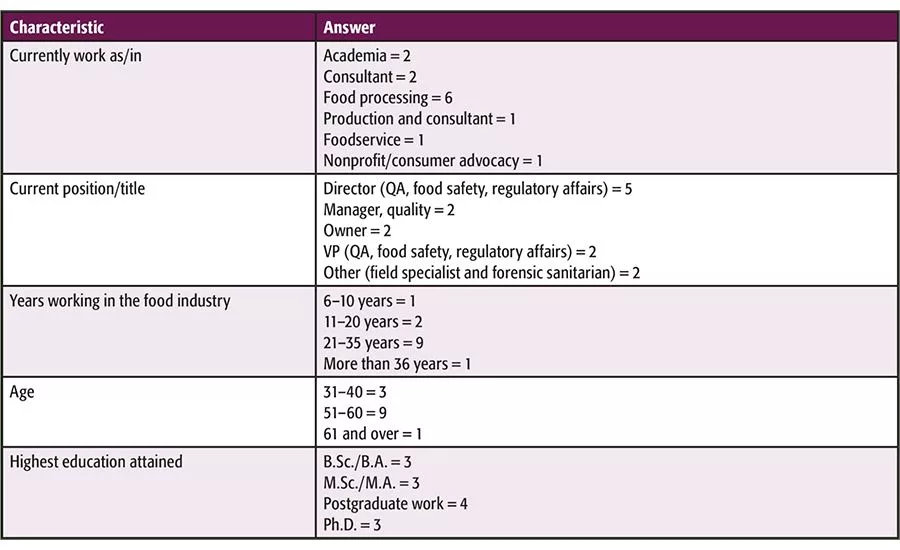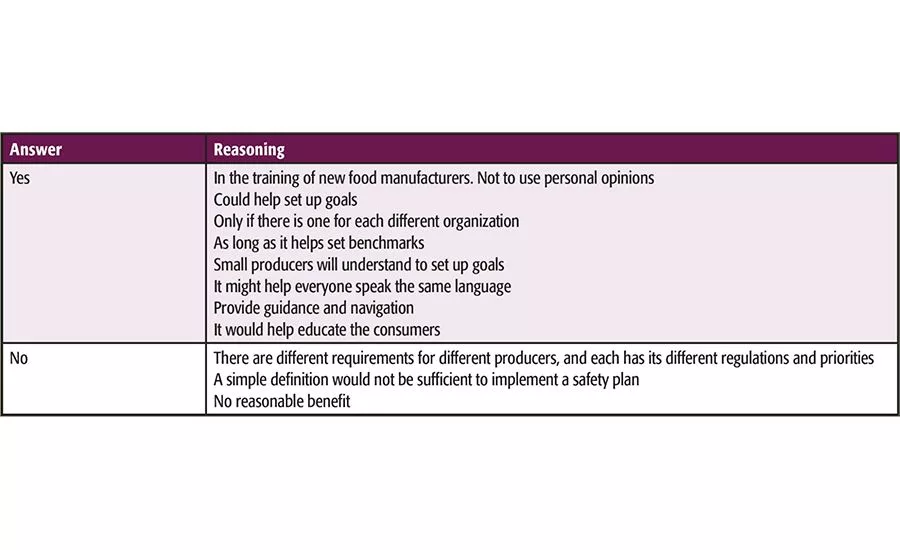The Complexity of Defining Food Safety
Digging deeper into survey responses




Our survey of food manufacturers on the meaning of food safety[1] revealed that food manufacturers have different definitions and wide variability in the words used to define food safety. As a follow-up, we interviewed 13 participants who completed the survey and volunteered to provide more insights into their interpretation of food safety.
All interviewees were from the U.S. and represented midcareer to late-career professionals in the food industry. Except for one interviewee, most participants have worked in the food industry for 11 years or more, and all interviewees have a managerial position with involvement in food safety or are responsible for food safety decisions. The demographics of the 13 interviews are summarized in Table 1. Table 2 shows the level of food safety training and food safety responsibilities for all interviewees.
Before the actual interviews, all participants were provided with a summary of the survey results (prepublication). When asked if they had read the summary, 85 percent of the interviewees responded yes. When asked if they had any particular comment or found anything striking about the results from the survey, the main comments were: 1) there is a wide range of definitions and interpretations of food safety, 2) food safety means different things to different people, and 3) the definition of food safety varies from what a typical consumer would consider food safety.
When asked if they thought there was a standardized definition of food safety, 85 percent responded no. Those who responded yes could not define food safety or were not sure there was a standardized definition of food safety.
When asked if there should be a standardized definition of food safety, 69 percent answered yes. When asked about the benefits of having a standardized definition of food safety, the reasons provided for yes answers included:
To provide less ambiguity and a common language:
- To create a common ground of understanding and consistency
- Everyone on the same page and eliminate confusion
- Major stakeholders would have a common language within the system and would provide clearer language for everyone to agree on goals
To help with training and education (food industry and public):
- Beneficial for training (make it easier to teach and for people to understand)
- It might increase awareness and facilitate understanding by consumers, public in general
- Will clarify expectations on how to improve it
Other reasons:
- It will ensure that manufacturers are controlling the right elements on what food safety actually is
- It would assist facilities as they develop their food safety plans
- Could provide a list of things to do for each segment within the food industry
When asked about the drawbacks or limitations of having a standardized definition of food safety, the answers provided were:
Complexity:
- There is an added complexity because it may vary with whom we ask. Regulators might say yes, while a consumer might have a different perspective
- It might be difficult to take into account all different disciplines
- It might mean different things within different industry segments
Difficulties in meeting standards:
- Some facilities will have difficulties meeting a standardized definition because of the diversity of food manufacturing, distribution, and consumption
- A standardized definition in legal terms may be difficult to achieve
- Consumers may still blur the line between food quality and food safety
Other reasons:
- It may stop the evolution of our understanding of food safety and the scientific achievement needed to cope with this evolution
- It will have to be reassessed and reevaluated periodically. What may be current today may not be current next year
- It could be too narrow and not serve all stakeholders
When asked if a standardized definition of food safety would help food manufacturers, 77 percent responded yes. Table 3 shows some of the reasons provided to support the answers to this question.
When asked how they think the public perception of food safety compares with the perception by food manufacturers, all but two interviewees agreed that the public understanding of food safety differs from the manufacturers’ understanding. One respondent thought there were differences in interpretation but not a gap, and another thought that the public, in general, has a good perception of food manufacturers in the U.S. Overall, there was a clearly perceived difference between the way consumers interpret food safety and the interpretation by food manufacturers. All comments could be grouped into two categories: Consumer trust in food safety and a simplified view of food safety by consumers versus a more complex view by food manufacturers. A few comments for each category were:
Consumer trust in food safety:
- Consumers, in general, tend to trust that the food is safe
- They (consumers) expect the product is safe the moment they buy it
Simple view from consumers versus a complex view from manufacturers:
- The public views it (food safety) as their personal interaction with the food, whereas those of us in the business view it along a continuum
- Consumers may not understand or agree with the way we perform risk-based analyses
This last category was the most important in interviewees’ minds. The public’s perception of food safety is considered to be narrower, more inconsistent with scientific knowledge, and out of sync with how food manufacturers understand food safety. Part of this difference was explained by a public that takes food safety for granted and has “ingrained expectations” and a perception molded by social media. The public follows trends originating on social media that may have little to do with the science behind the safety of a particular food. The answers included an understanding by manufacturers that some food safety demands by the public may not be valid, but it does not matter because the manufacturers will comply to be able to sell the product.
Looking for quick answers on food safety topics?
Try Ask FSM, our new smart AI search tool.
Ask FSM →
When asked how we could help bridge any gap in the understanding of food safety between the public and food manufacturers, all interviewees provided some ideas on how to reduce this gap, with emphasis on education. One interviewee suggested that the industry should use food safety as a marketing tool to communicate with the public. Another interviewee emphasized a simplification of food safety regulations, including labels, to bridge the gap. Here, the example was the “fresh” label on chicken shipped at 22 °F, which is below freezing. This label creates confusion with the public, which sees frozen chicken as “fresh,” and allows for the “wrong perception.” Most of these themes included mainly education in a different context, such as: 1) educating the public about food safety along the continuum (not only in groceries or restaurants), 2) increasing presence in social media, 3) increasing advertising related to food safety, and 4) using food shows on television as a vehicle to discuss food safety. One interviewee, however, suggested that educating the public on every aspect of food manufacturing might be misleading to the public and counterproductive.
At the end of the interviews, when respondents were asked if they would like to add anything else, six interviewees declined to give further comments. Some quotes from the other interviewees were:
“The more we know, the safer can be the assumption: Is it food I can trust?”
“Cleaning up the rules and regulations and leveling the playing field and educate the consumer a little bit more.”
“We don’t discuss food safety enough…I think that people assume that their food will be safe.”
“From what I’ve seen from this survey, there are a lot of definitions of food safety.”
“The discipline of food safety is hard to define…each individual’s definition comes from their own experience.”
“I wish, on consumer education, that manufacturers across the board would continue…and get more engaged…and see their roles in food safety for consumers.”
“There are things I think about frequently, having a role in food safety…What do people need to know? What is helpful for the public to know? And how do we create that communication?”
“There is a gap there that we might all benefit from if we can close it a little bit.”
These interviews brought some insights into the current thinking about food safety by food industry professionals. Our findings corroborate the wide variability in the interpretation of food safety and even provide some reasoning for why a standardized definition of food safety is complex, and perhaps elusive.
With the exception of one participant, who thought that the different words used to describe food safety do not matter because everybody understands food safety at the same level, all interviews highlighted the multiple dimensions of a complex issue: the interpretation of food safety.
All interviewees either knew there is no standardized definition of food safety or were unable to produce one. Only 69 percent responded favorably to the question “Should there be one standard definition?” The reasons for or against having a standardized definition were equally strong. Most of the reasoning for a standardized definition centered on providing common language with less ambiguity and helping with training. There were very few other compelling reasons, and these mainly were: ensure manufacturers control the right food safety elements, assist in the development of food safety plans, and provide things to do for each segment of the food industry.
There was consensus that a standardized definition would help with food safety training but less consensus on whether such a definition would help with different interpretations. The reasoning against a standardized definition centered on the complexity of this topic and the challenges for the industry to meet “standards” that could come from such a definition. The other compelling “against” reasons included: 1) it would stop the evolution of our understanding of food safety and the scientific achievement needed to cope with it; 2) the need for periodic reassessment and evaluation; 3) the definition may be too narrow and not serve all stakeholders; 4) the definition might not apply to everybody and might create conflicts.
A major point of agreement among all interviewees was the differences in the perception of food safety by consumers versus food manufacturers. This question was meant to include the word “perception” and not “understanding.” From the previous survey, we could extract that an “understanding” of food safety implies understanding “management, handling, practices, procedures, preparation, and/or manufacturing” that when “properly implemented” will result in “safe food products.” For the interviews, we chose the word “perception” because it may be more appropriate to define the way the public reacts to food safety. However, it could be argued that perception is reality, and therefore knowledge, for the public.
The higher number of participants wishing for a standardized definition of food safety, contrasted with a series of important limitations for the formulation and implementation of such a definition, highlights a logical conundrum in the minds of people with expertise in food safety: a desire for a standardized definition of food safety, but the knowledge that such a definition could not be easily formulated, or if formulated not easily accepted by many in the food industry.
Reference
1. www.food-safety.com/magazine-archive1/aprilmay-2020/the-meaning-of-food-safety/.
Omar A. Oyarzabal, Ph.D., is an associate professor of food safety at the University of Vermont.
Barbara B. VanRenterghem, Ph.D., is the editorial director of Food Safety Magazine.









